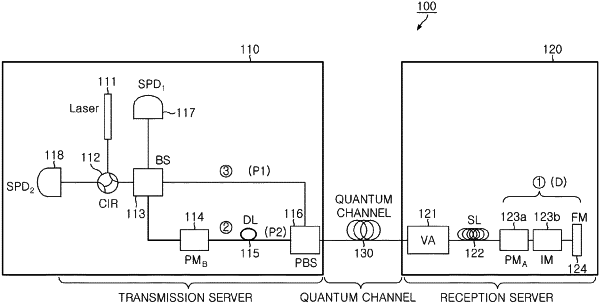| CPC H04L 9/0858 (2013.01) [G02B 5/3025 (2013.01); G02B 27/283 (2013.01); H04B 10/532 (2013.01); H04B 10/70 (2013.01); H04L 9/0827 (2013.01); G02B 27/286 (2013.01); H04L 9/0852 (2013.01)] | 11 Claims |

|
1. A quantum key distribution system for distributing a quantum cryptographic key to a transmitter and a receiver, the quantum key distribution system comprising:
the transmitter configured to split an optical signal into a first optical signal passing through a first path (P1) and a second optical signal passing through a second path (P2), which is longer than the first path (P1), and to sequentially transmit the first optical signal and the second optical signal; and
the receiver configured to receive the first optical signal and the second optical signal incident through a quantum channel and transmit the first optical signal and the second optical signal back to the transmitter passing through the quantum channel after passing through a polarization-dependent element, being reflected by a Faraday mirror, and passing through the polarization-dependent element again,
wherein a difference (dL=LP2−LP1) between a length (LP1) of the first path (P1) and a length (LP2) of the second path (P2) in the transmitter is equal to or greater than twice a distance (=D) between the polarization-dependent element and the Faraday mirror (dL>2D).
|